Pancancer landscape analysis of the thymosin family identified TMSB10 as a potential prognostic biomarker and immunotherapy target in glioma
- PMID: 36163046
- PMCID: PMC9513945
- DOI: 10.1186/s12935-022-02698-5
Pancancer landscape analysis of the thymosin family identified TMSB10 as a potential prognostic biomarker and immunotherapy target in glioma
Abstract
Background: Thymosin family genes (TMSs), biologically important peptides with diverse intracellular and extracellular functions, have been shown to promote the progression of multiple cancers. However, multiomics characterization of TMSs and their role in human cancer prognosis has not been systematically performed.
Methods: We performed a comprehensive analysis of TMSs and thymosin β10 (TMSB10) using multiomics data from more than 10,000 tumor samples of 33 cancer types from The Cancer Genome Atlas (TCGA). We used single-sample gene set enrichment analysis (ssGSEA) and the gene set variation analysis (GSVA) algorithm to investigate the differences in tumor microenvironment (TME) cell infiltration and functional annotation for individual tumor samples, respectively. The role of TMSB10 in the malignant progression of glioma, the promotion of macrophage infiltration,and immunosuppressive polarization, and the combination drug efficacy were assessed via biological function assays.
Results: We comprehensively assessed genomic mutations, expression dysregulation, prognosis and immunotherapeutic response across 33 human cancer samples and showed that TMSB10 is specifically overexpressed in almost all types of cancer tissues. Further pan-cancer analysis showed that TMSB10 is closely related to the biological function, immune regulation and prognosis of glioma. Similar results were also found in several public glioma cohorts and our Qilu local cohort. Further integration with other biological experiments revealed the key roles of TMSB10 in the malignant progression of glioma, the promotion of macrophage infiltration and immunosuppressive polarization. We also identified multiple drugs targeting cells with high TMSB10 expression and validated that knockdown of TMSB10 improved the efficacy of selumetinib (a MEK1/2 inhibitor approved by the FDA for the treatment of neurofibromatosis-associated tumors) and anti-PD1 treatment in glioma.
Conclusion: These results indicate that TMSB10 holds promise as a novel prognostic marker and therapeutic target, providing a theoretical basis for the development of more effective and targeted clinical treatment strategies for glioma patients.
Keywords: Glioma; Immune checkpoint blockade; Pancancer; TMSB10; Tumor microenvironment.
© 2022. The Author(s).
Conflict of interest statement
The authors declare that they have no competing interests.
Figures
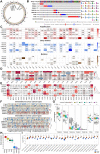
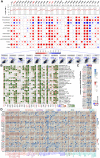
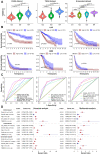
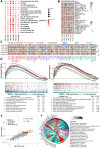
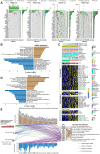
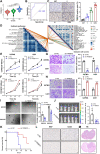
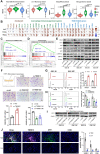
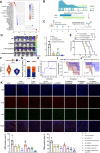
Similar articles
-
Pan-cancer analysis identifies the correlations of Thymosin Beta 10 with predicting prognosis and immunotherapy response.Front Immunol. 2023 May 18;14:1170539. doi: 10.3389/fimmu.2023.1170539. eCollection 2023. Front Immunol. 2023. PMID: 37275863 Free PMC article.
-
The Clinical Relevance and Functional Implications of Thymosin Beta-10 in Glioma.Genet Res (Camb). 2023 Nov 9;2023:5517445. doi: 10.1155/2023/5517445. eCollection 2023. Genet Res (Camb). 2023. PMID: 38026448 Free PMC article.
-
TMSB10 acts as a biomarker and promotes progression of clear cell renal cell carcinoma.Int J Oncol. 2020 May;56(5):1101-1114. doi: 10.3892/ijo.2020.4991. Epub 2020 Feb 19. Int J Oncol. 2020. PMID: 32319572 Free PMC article.
-
Thymosin β10 promotes tumor-associated macrophages M2 conversion and proliferation via the PI3K/Akt pathway in lung adenocarcinoma.Respir Res. 2020 Dec 22;21(1):328. doi: 10.1186/s12931-020-01587-7. Respir Res. 2020. PMID: 33349268 Free PMC article.
-
The Glioma Immune Landscape: A Double-Edged Sword for Treatment Regimens.Cancers (Basel). 2023 Mar 28;15(7):2024. doi: 10.3390/cancers15072024. Cancers (Basel). 2023. PMID: 37046685 Free PMC article. Review.
Cited by
-
Pan-cancer analysis identifies the correlations of Thymosin Beta 10 with predicting prognosis and immunotherapy response.Front Immunol. 2023 May 18;14:1170539. doi: 10.3389/fimmu.2023.1170539. eCollection 2023. Front Immunol. 2023. PMID: 37275863 Free PMC article.
-
Heterotypic macrophages/microglia differentially contribute to retinal ischaemia and neovascularisation.Diabetologia. 2024 Oct;67(10):2329-2345. doi: 10.1007/s00125-024-06215-3. Epub 2024 Jul 8. Diabetologia. 2024. PMID: 38977459
-
The Clinical Relevance and Functional Implications of Thymosin Beta-10 in Glioma.Genet Res (Camb). 2023 Nov 9;2023:5517445. doi: 10.1155/2023/5517445. eCollection 2023. Genet Res (Camb). 2023. PMID: 38026448 Free PMC article.
References
Grants and funding
- 81874083; 82072776; 82072775; 81702468; 81802966; 81902540; 641 81874082; 81472353/National Natural Science Foundation of China
- 81874083; 82072776; 82072775; 81702468; 81802966; 81902540; 641 81874082; 81472353/National Natural Science Foundation of China
- ZR2019BH057 ZR2020QH174 ZR2021LSW025/Natural Science Foundation of Shandong Province
- 2021GXRC029/Jinan Science and Technology Bureau
- 2020SDUCRCA011/Key clinical Research project of Clinical Research Center of Shandong University
LinkOut - more resources
Full Text Sources
Research Materials
Miscellaneous

